
Amy Johnston · 15th October 2025
Dreamforce 2025 Day Two: Key updates for admins, developers, industry verticals, and more
Take a look inside Day Two of Dreamforce 2025, and recap the key highlights and announcements from keynotes, sessions, workshops, and more — and learn what they mean for Salesforce DevOps teams.
It will come as no surprise that Dreamforce Day Two delved deeper into Salesforce’s new agentic technology, focusing on how it can enhance the productivity and impact of admins and developers in their daily work. While Day One introduced the Agentic Enterprise, today’s sessions shifted from vision to execution.
Admin Keynote: from clicks to conversations
The Admin Keynote introduced major updates showcasing how new Agentforce 360 capabilities will make setup, configuration, and automation faster, safer, and more conversational.
Setup powered by Agentforce
The headline announcement was Setup powered by Agentforce, a redesigned admin experience that brings intelligent assistance into the heart of the Setup workspace. Admins can now complete over 30 “Jobs to Be Done” through natural language — from creating fields and managing user access to resolving validation rule errors — all with built-in confirmation and audit trails. Every suggestion from the Setup agent respects existing permissions and is logged through the Setup Audit Trail, while the Einstein Trust Layer ensures governance and data security stay intact.
The message was clear: the future of admin work is moving from clicks to conversations — but with the same discipline and control admins already rely on.
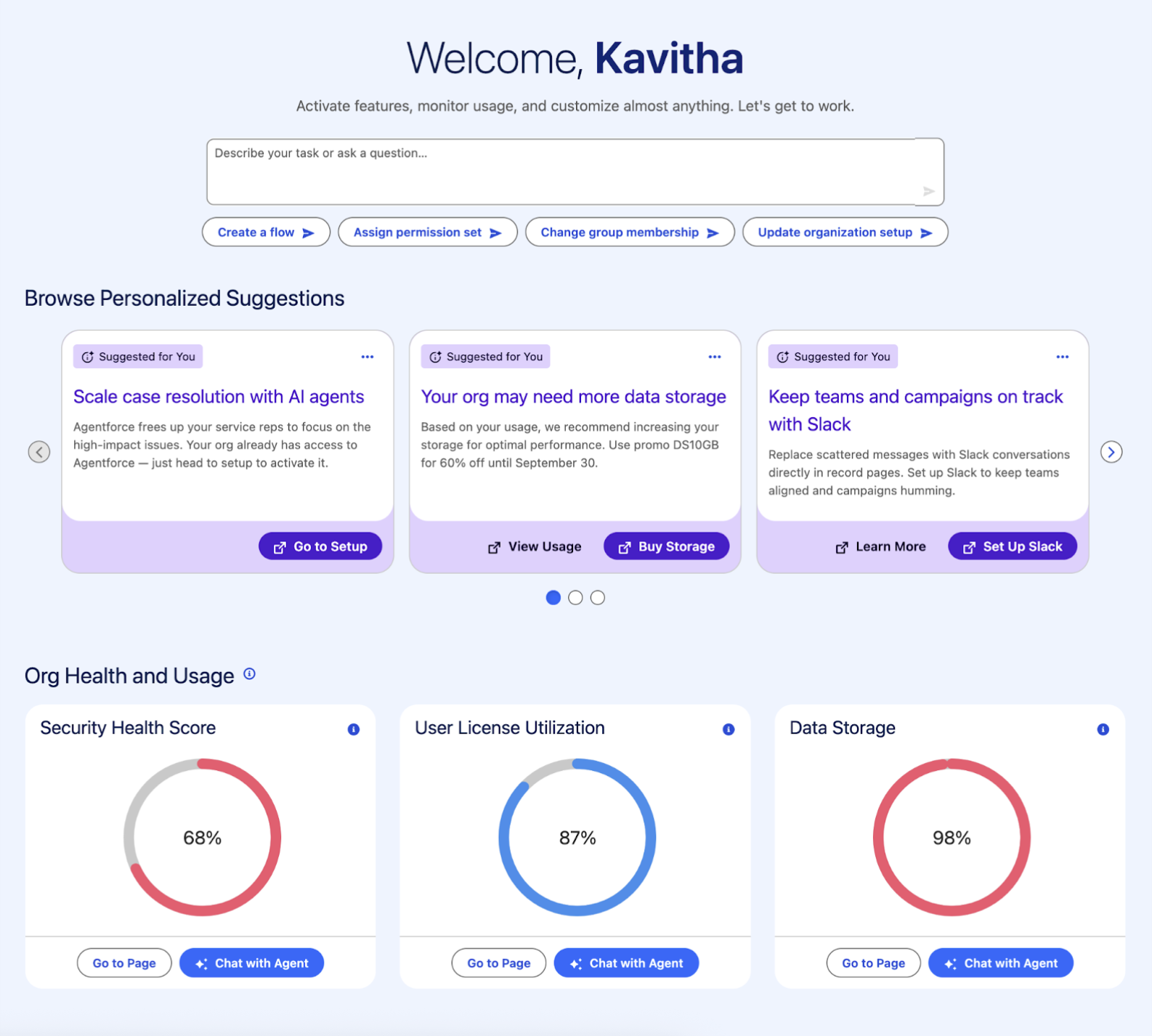
Flow upgrades
Salesforce placed Flows at the center of its automation strategy, with new conversational and governance-friendly features. Admins can now describe a record-triggered or scheduled automation in plain language, and Agentforce will scaffold the Flow, presenting a human-in-the-loop review before creation.
Furthermore, approvals are now native to Flow — meaning you can build approval paths with timeouts, notifications, and post-approval updates without leaving the Flow builder. For existing automations, a new “Explain this flow” feature generates readable summaries, simplifying audits and handovers. And deployment day is easier too: metadata and reference data can now be bundled together, so automations and their supporting data go live in one step.
Object and configuration creation
Admins can now create custom objects and fields through conversation. Agentforce proposes a design, highlights where existing picklists or relationships can be reused, and asks for approval before creation. This reduces duplicate fields and keeps orgs cleaner and easier to maintain.
Agentforce Builder (admin view)
A new Agentforce Builder (Beta in November 2025) gives admins a document-style workspace for defining and testing agents that support business processes. Admins can edit instructions in a canvas, test behavior in real time, and keep a human in the loop before publishing. The layout shows topics, data connections, and dependencies at a glance, with a built-in simulator to validate agent actions before they reach end users.
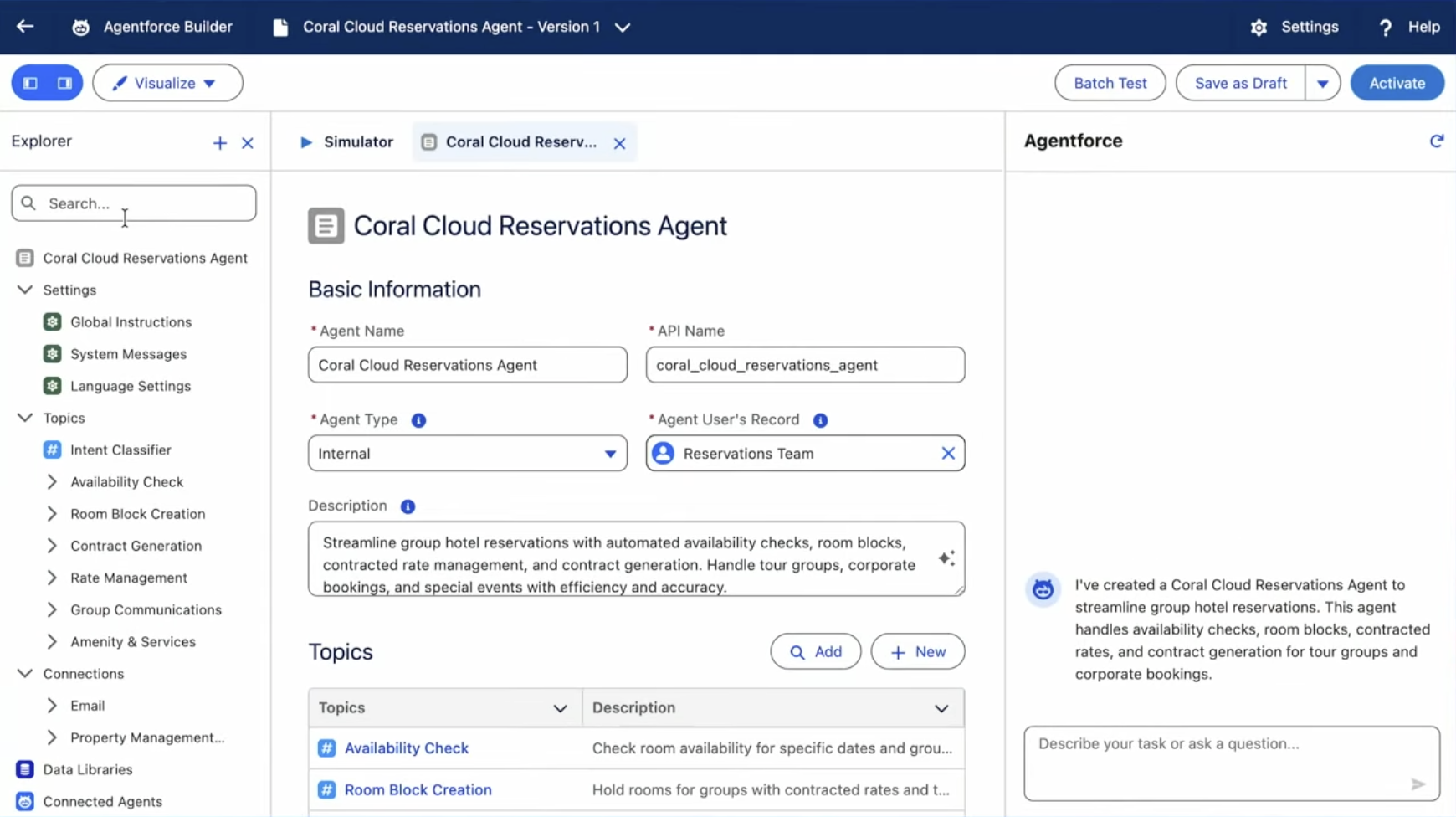
Slack and agents
Slack was positioned as the conversational interface for the Agentic Enterprise. With Auto Slack, admins can now spin up Slack workspaces that respect Salesforce permissions — so agents only see what the requesting user can see.
In the demo, an “Aloha” agent coordinated reservations, ingested spreadsheets, placed procurement orders, and shared Tableau visualizations — all within one Slack thread. This model lets teams handle real-world processes through conversation while keeping permissions, context, and compliance intact.
Salesforce also previewed a new Slackbot AI assistant, due in early 2026, that assembles meeting briefs, queries calendars and Salesforce data, drafts messages, and helps users prepare for customer conversations — all through conversational prompts.
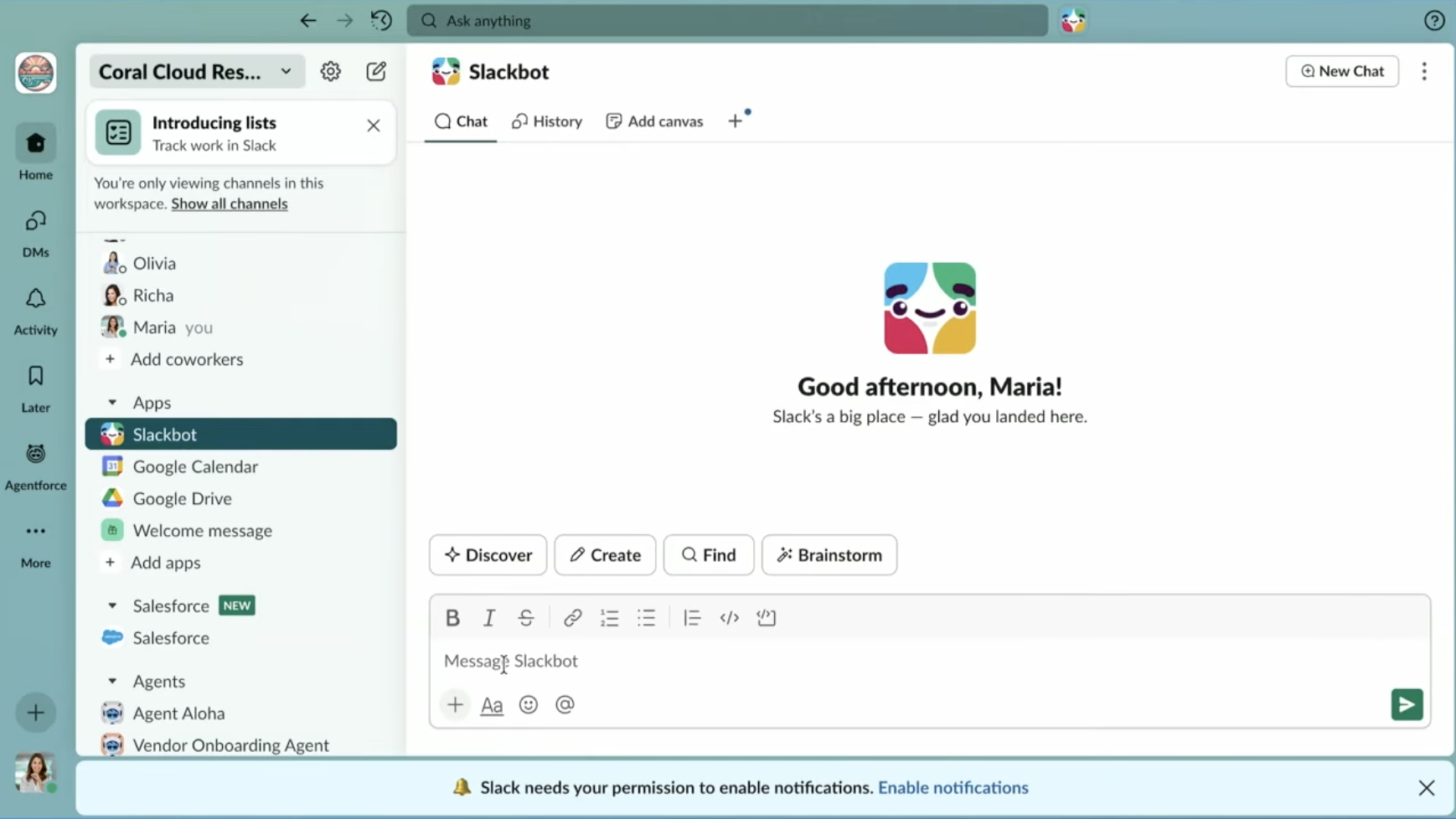
Security and trust
Security updates focused on visibility and automation. Admins can now ask Agentforce to troubleshoot permissions directly — for example, “Why can’t this user edit Opportunities?” — and receive a guided diagnosis that identifies access gaps and suggests fixes with confirmation steps to maintain least privilege.
Elsewhere, Shield’s Data Detect now flags sensitive data stored in the wrong places, Security Center provides multi-org posture visibility, and a new Security with Agentforce feature can run automated risk assessments and highlight unusual activity. Admins can even ask broad questions like “Show me high-risk security settings” to generate an actionable starting list.
DX Inspector (change tracking and deployment)
The new DX Inspector gives admins real-time visibility into metadata changes in sandboxes. Admins can select exactly what to deploy, and — in a major workflow improvement — use the new Data tab to include reference data in the same transaction. The demo showed a full end-to-end loop: building in Setup powered by Agentforce, reviewing changes in DX Inspector, adding seed data, and pushing both metadata and data live together.
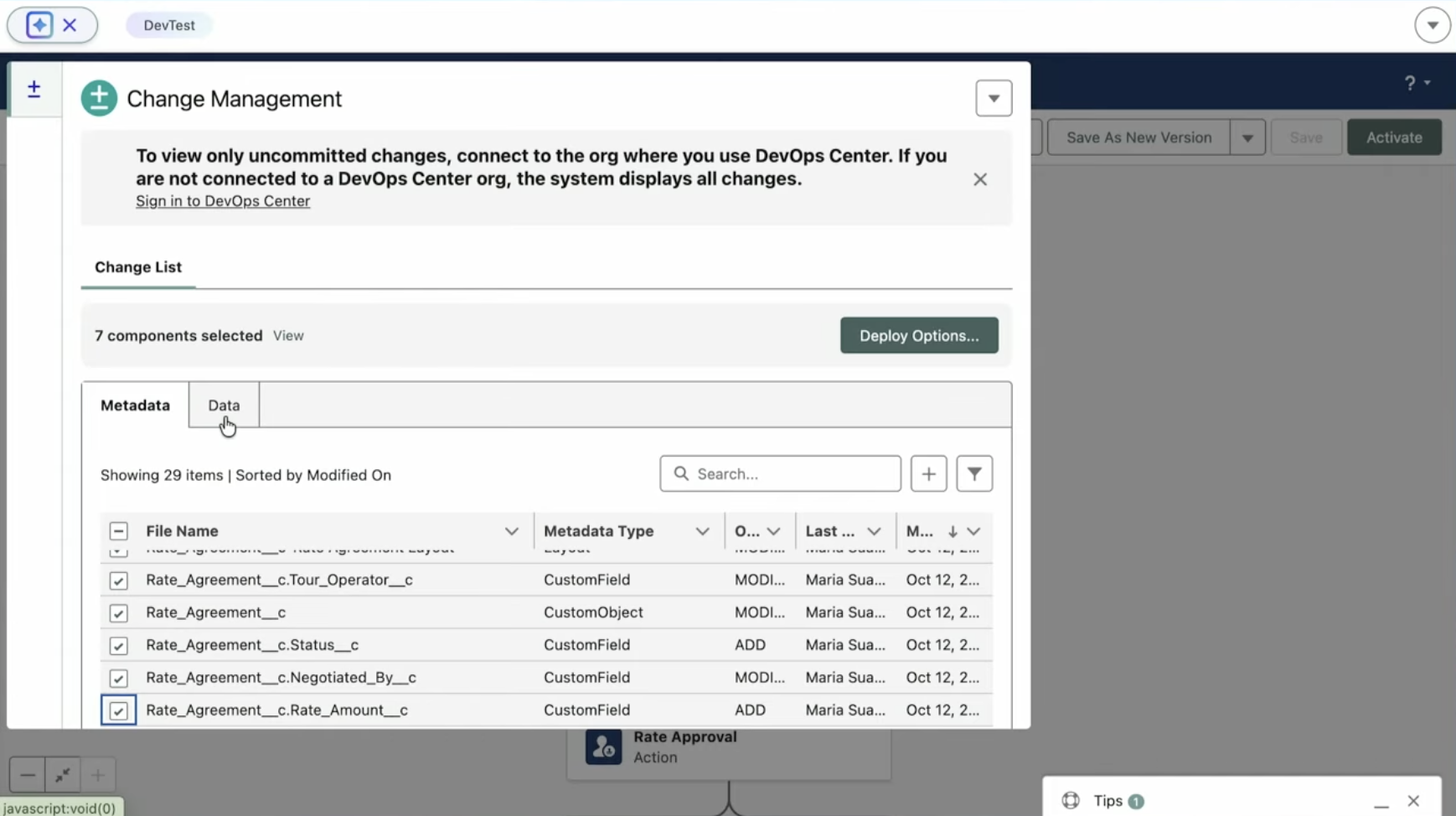
Intelligent and conversational experiences
Admins can now deploy agent experiences across multiple surfaces — from generating documents and processing forms to embedding agents in Slack for collaboration with internal teams or external partners via Slack Connect. These conversational workflows maintain the same governance, auditability, and permission boundaries as traditional automation.
Why these admin updates matter for DevOps
The admin-focused announcements at Dreamforce 2025 highlight how AI and automation are reshaping the way change is made — and governed — in Salesforce environments.
With Setup powered by Agentforce, Flow upgrades, and the new DX Inspector, more configuration and automation will now originate from conversational interactions. That means DevOps teams will play a growing role in ensuring these AI-assisted changes remain traceable, testable, and secure.
Flows that can now include approvals, notifications, and bundled data bring greater efficiency, but they also demand version control and validation. Similarly, Agentforce Builder and Slack integrations expand where work happens — introducing new change surfaces that must be observed and governed within existing CI/CD pipelines.
Meanwhile, Security with Agentforce and permission diagnostics reinforce the shift toward DevSecOps, where security checks are embedded in automation rather than handled after deployment.
In short, as conversational setup and agent-driven configuration become part of everyday work, pipelines must evolve to provide visibility, auditability, and rollback for AI-assisted change.
Developer Keynote: from code to orchestration
If the Admin Keynote focused on configuration, the Developer Keynote looked at how Salesforce developers will build, test, and govern in the agentic era. The session centered on new tools designed to make development more conversational, more intelligent, and more connected to data and governance.
Agentforce Vibes: enterprise “vibe coding”
Salesforce positioned Agentforce Vibes as an AI pair-programmer built for enterprise-grade development — grounded in org metadata, permissions, and governance.
In the live demo, Vibes generated a Lightning Web Component from plain language, previewed it locally, and deployed it in minutes. It then applied a Figma design to automatically refactor the component’s code and styling to match the brand spec. The team also modified a React/Next.js app running on Salesforce infrastructure by simply asking Vibes to make changes, like adding a star-rating field.
Developers will be able to define approval modes for edits, enforce coding standards, and review AI-generated code before merging — introducing automation without losing oversight.
Unified Catalog: metadata meets Data360
The new Unified Catalog brings every layer of metadata — objects, fields, automations, and components — into Data 360. Developers can use natural language to search across the catalog or run retrieval-augmented generation (RAG) queries against it. It can even auto-describe undocumented assets, helping teams and agents understand what exists before building on it.
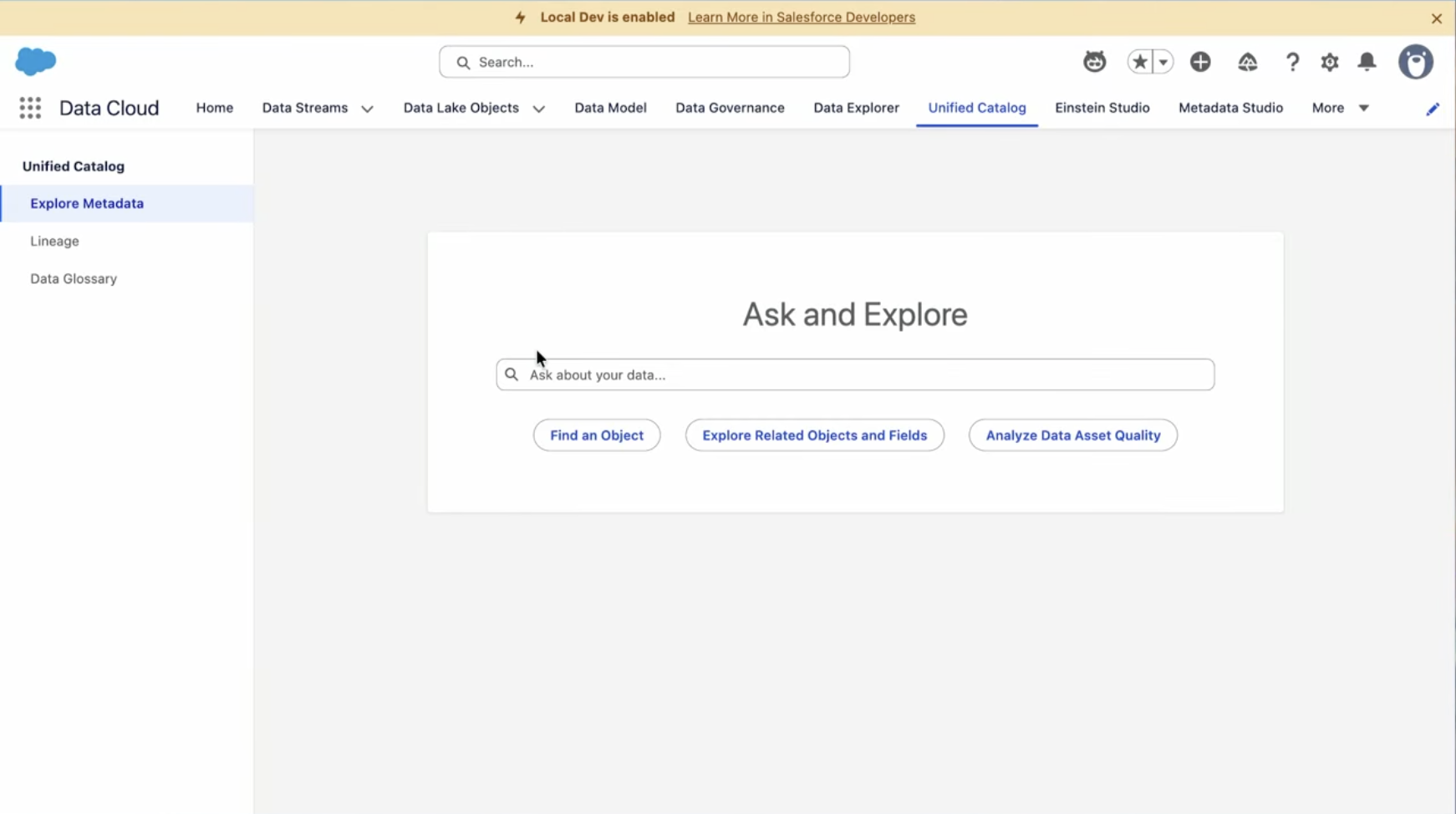
MCP servers: giving agents tool awareness
Salesforce introduced the Model Context Protocol (MCP) as a universal translator that allows agents to understand which tools and APIs they can safely use. Two versions were shown:
- Local MCP, for developer tools like Salesforce DX commands.
- Platform-hosted MCP, exposing trusted APIs such as describe, query, and data operations.
Teams will also be able to host their own MCP servers and connect them to Agentforce Vibes or the new Vibes CLI, letting developers access platform capabilities through natural language directly in the terminal.
The new Vibes CLI mirrors the conversational power of Vibes in the terminal. As well as querying MCP servers, developers can also run tasks and inspect build environments using natural language — making automation more accessible and interactive.
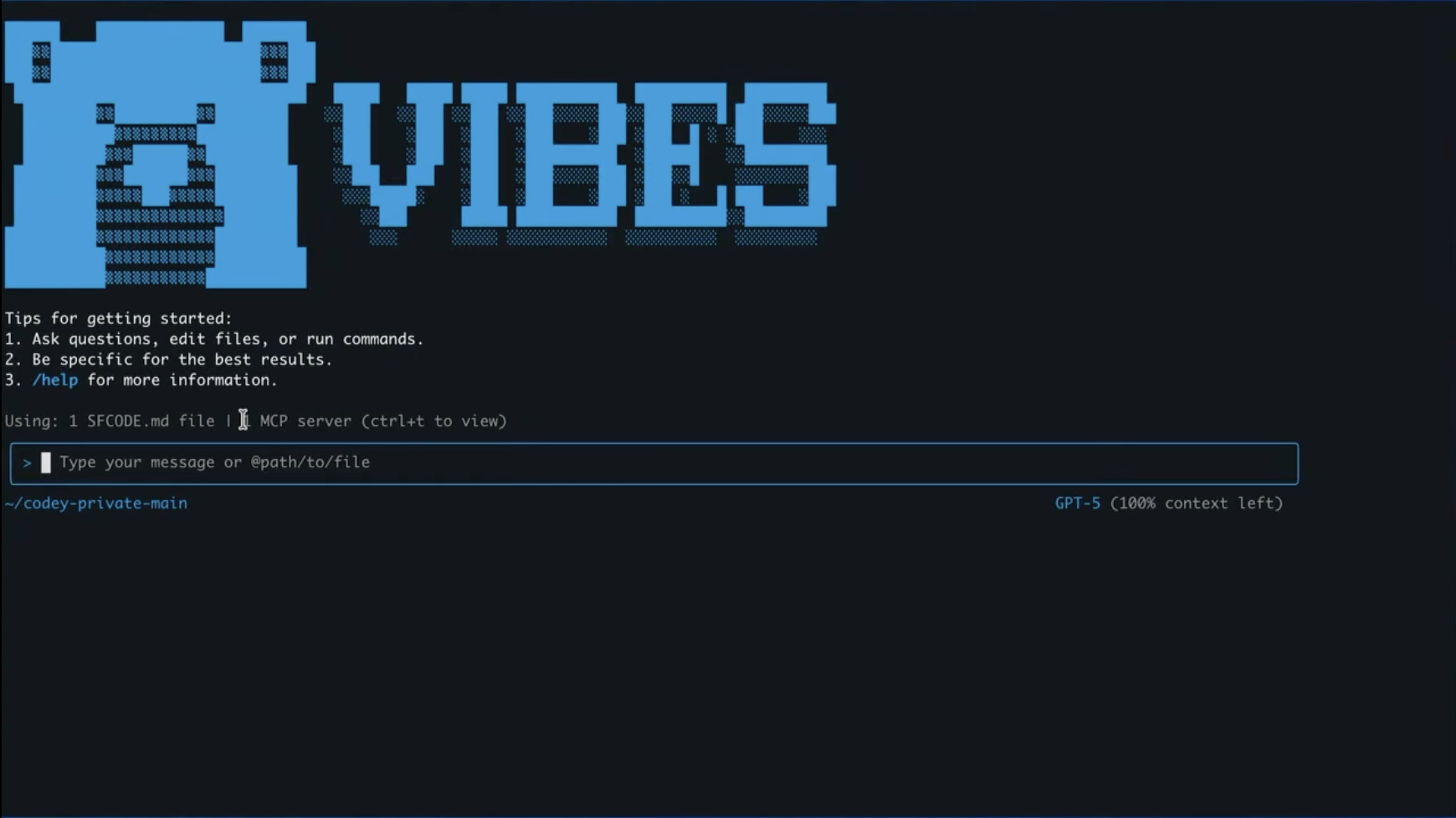
Agentforce Builder and AgentScript: predictable agents
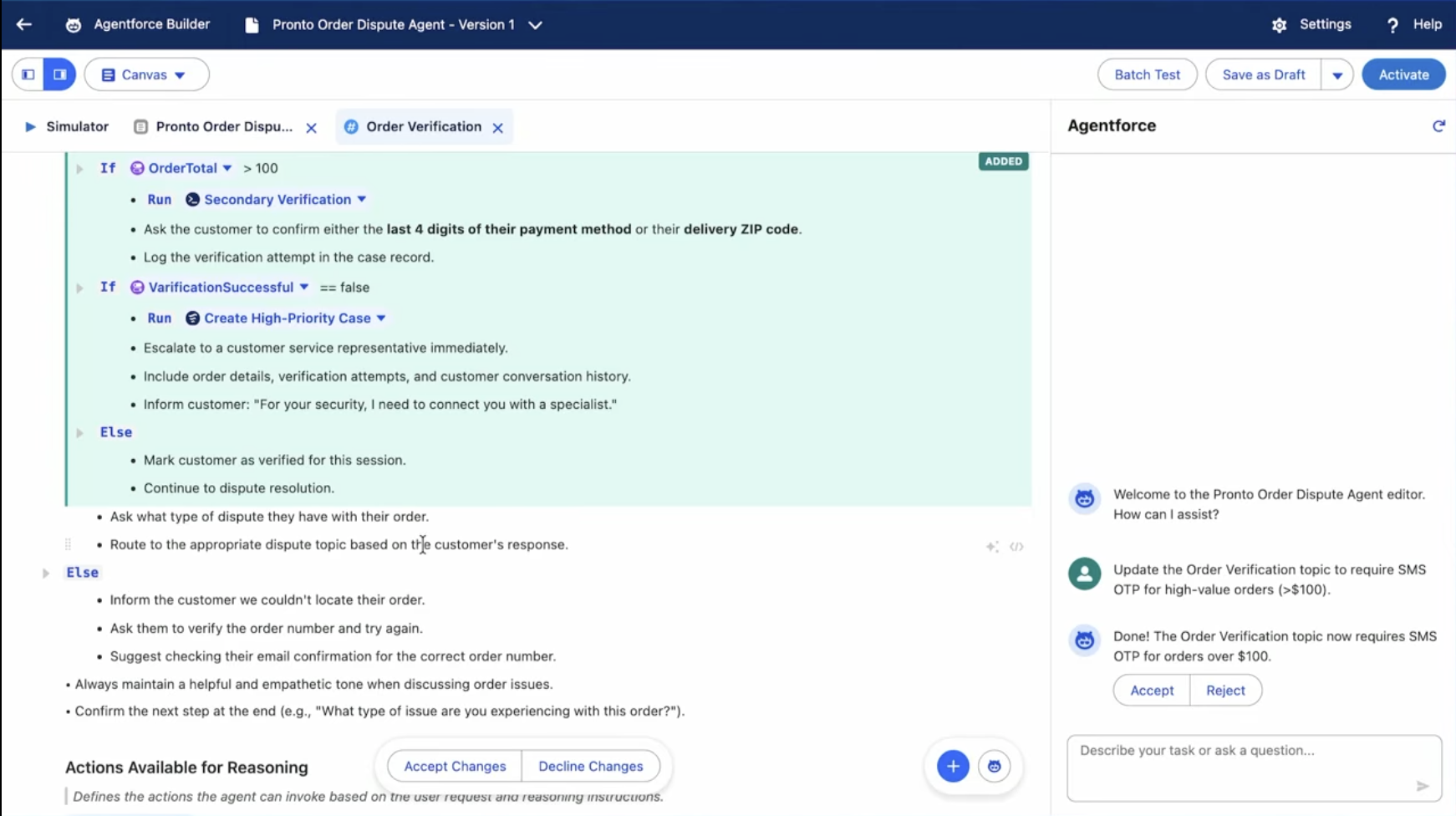
The Agentforce Builder (in Pilot) has been redesigned to bring rules and reasoning together. Developers will be able to define topics, variables, and conditionals in a visual canvas, then switch to AgentScript — Salesforce’s new scripting language for predictable agent behavior.
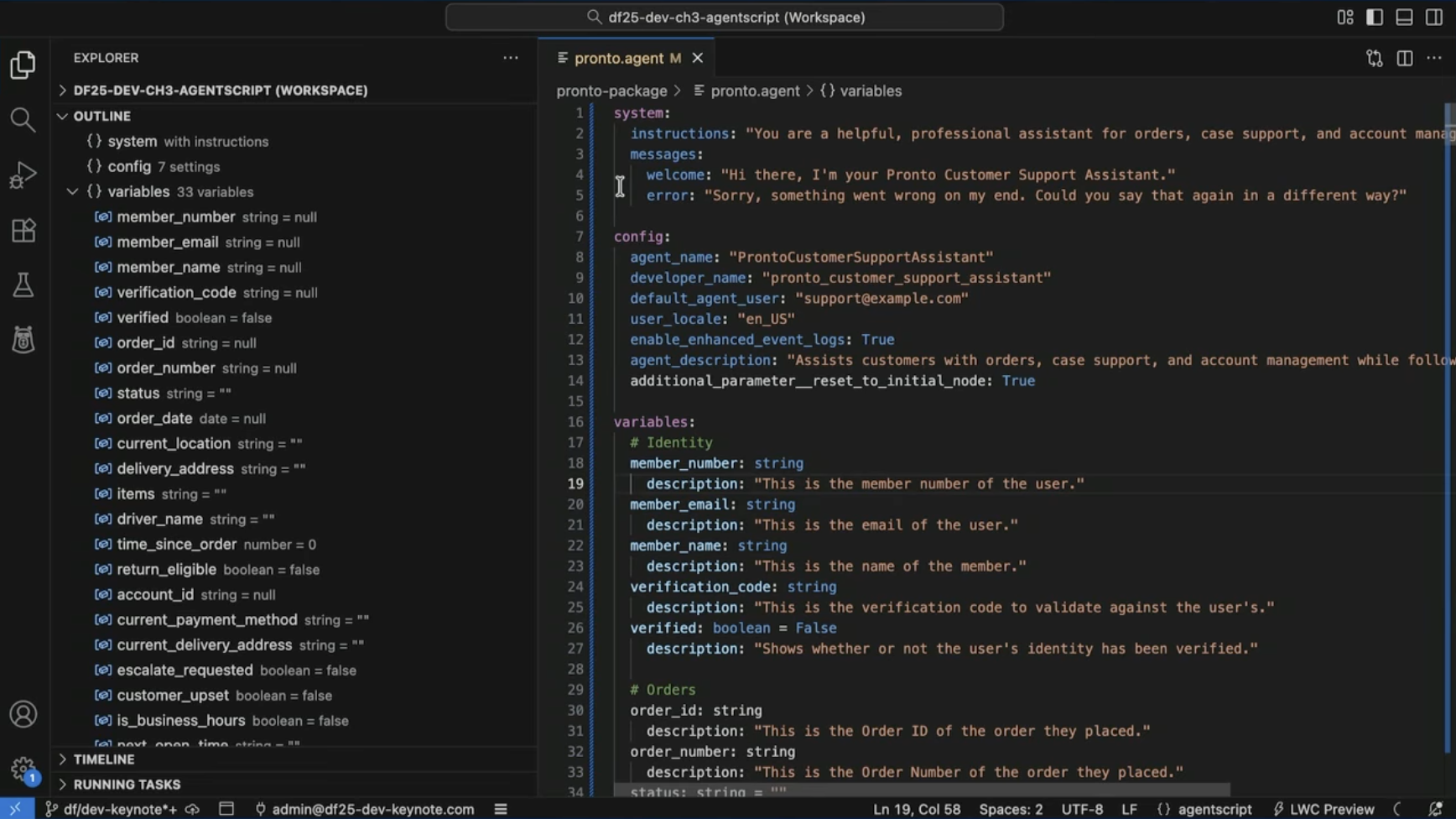
This hybrid model combines deterministic, policy-driven logic with AI reasoning, helping developers create reliable, testable agents for complex business processes.
Prompt Builder: conditional logic in prompts
Prompt Builder now supports conditional expressions based on AgentScript syntax. This lets developers add branching logic (like if/else) directly into prompts, reducing duplication and improving consistency across agent behaviors.
Scale Center and Apex Guru
Scale Center and Apex Guru are now available across all customer editions. Embedded agents can summarize org health, identify performance bottlenecks, and propose fixes. Apex Guru Runtime Insights now appear directly in Agentforce Vibes, surfacing recommendations during development rather than after deployment. Alerts can also post to Slack, closing the feedback loop between diagnostics and action.
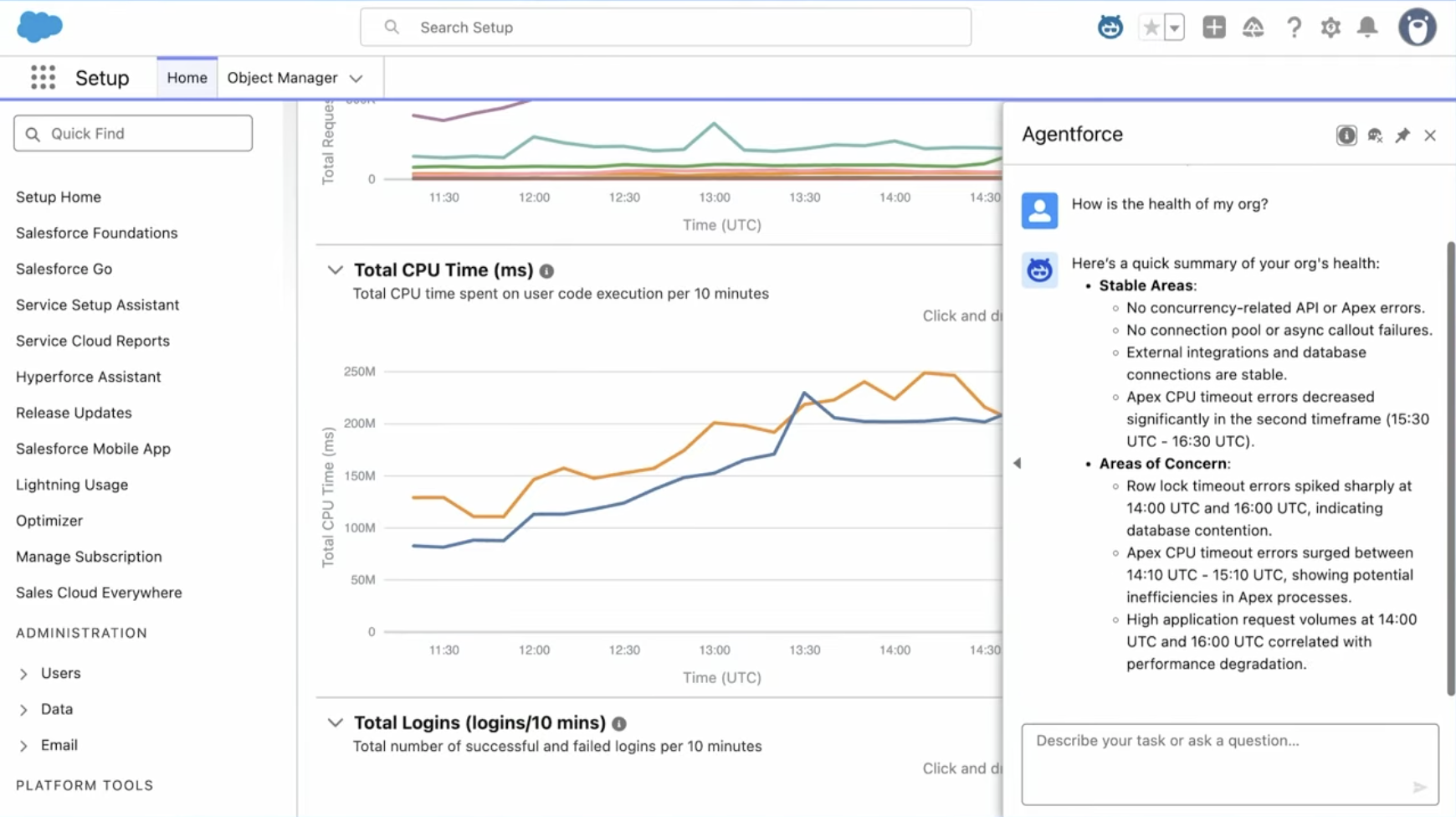
Conversational UX and Slack
Salesforce showcased a live paid-search agent used by its marketing team, running in Slack. The agent compiled cross-channel data from Google Ads, LinkedIn, and Analytics via Data 360, then published structured results into Slack Canvas.
Behind the scenes, the workflow used a governed semantic data model — ensuring consistency between Slack outputs, Tableau dashboards, and external queries via the new Semantic Gateway API.
Build on any framework
Salesforce confirmed that developers can now build and deploy React and Next.js apps directly on the Salesforce platform. These apps inherit Salesforce’s identity, data, and security layers, giving developers more flexibility while maintaining compliance and platform standards.
The future of ALM
Salesforce closed the keynote by outlining its direction for next-generation application lifecycle management (ALM). The roadmap includes Salesforce Studio + Projects — an AI-powered release planning and management hub — and new DX ALM APIs that let partners extend or even replace DevOps Center. Together with DX Inspector, this signals a move toward more agentic, extensible release management across the lifecycle.
Why this matters for DevOps
With tools like Vibes, AgentScript, and MCP servers, more of the development process will be automated or assisted — but those same capabilities need strong governance. Pipelines will need to be able to validate AI-generated code, version and roll back agents, and monitor their reasoning in production.
The Unified Catalog and DX Inspector bridge the gap between configuration and code, helping DevOps teams trace dependencies across metadata and data. Meanwhile, the ALM roadmap hints at a future where CI/CD integrates directly with agentic tooling.
Vertical, partner, and other notable highlights
Day Two also focused on how Salesforce’s agentic vision is being applied across industries, extended by partners, and expanded through the broader platform ecosystem.
Industry applications of the Agentic Enterprise
Salesforce showcased several live examples of how agentic technology is already transforming work across verticals:
- Financial Services: Agents performed transaction monitoring and compliance reporting in real time, surfacing anomalies for human review. By combining Data 360’s contextual grounding with defined governance policies, financial institutions can now track decision paths to meet audit standards.
- Public Sector: This keynote framed the Agentic Enterprise as a tool for mission-driven transformation, showing how governments and civic organizations can use Agentforce to streamline citizen services, manage trust and compliance, and scale impact across communities.
- Consumer Goods: Salesforce highlighted how the agentic model is being applied in retail — intelligent assistants managing inventory, optimizing pricing strategies, and personalizing customer journeys — all driven by real-time data and conversational insights.
Partner ecosystem momentum
Salesforce partners were a visible part of the Day Two program. Deloitte, Accenture, and PwC each demonstrated early frameworks for agent governance, training, and orchestration, built on top of Agentforce 360.
These partner-led solutions included compliance agents that monitor internal policy adherence, customer-service agents pre-trained on sector data, and deployment templates that align agentic workflows with existing IT governance.
Data 360 and context as code
Salesforce also expanded on Data 360 (formerly Data Cloud), positioning it as the connective layer for context-driven development. Structured and unstructured data are now unified within the same framework, enabling agents and developers to treat context as a programmable resource — a concept Salesforce referred to as “context as code.”
This enhancement allows teams to link metadata, documents, and real-time data streams directly to agent reasoning, reducing duplication and improving accuracy.
ISV marketplace for agents
Salesforce confirmed that an ISV marketplace for agents will launch later in 2025. The marketplace will let developers and partners publish pre-built, domain-specific agents, frameworks, and extensions that can be installed directly into Salesforce orgs.
This opens the door for reusable, configurable agent components — from support bots and compliance monitors to task automation templates — expanding how teams adopt agentic capabilities without starting from scratch.
Agentforce Keynote: rounding up the day with agents for every cloud
The final keynote of Day Two focused on how Salesforce’s Agentforce 360 platform is evolving into a governed, production-ready system. The session highlighted new ways to build, test, and monitor intelligent agents with a focus on control, predictability, and observability.
Agentforce 360: the next evolution
Salesforce described Agentforce 360 as the next major phase of its agent platform, structured around four pillars:
- Control and predictability, through the use of AgentScript and structured reasoning.
- Context processing, allowing agents to understand and act on complex data.
- Multi-channel experiences, spanning web, Slack, and Voice.
- Management and scale, with new observability and orchestration tools.
These updates show how Salesforce is standardizing the development and operation of enterprise-grade agents within secure and auditable frameworks.
AgentScript and the new Agent Builder
As we saw in both the admin and developer keynotes, the Agent Builder has been redesigned to blend natural-language authoring with deterministic logic. Agents can be created conversationally or refined using AgentScript, Salesforce’s new scripting layer for rule-based steps, conditionals, and variables.
The new real-time simulator visualizes how an agent reasons before deployment, giving teams a way to validate logic and ensure reliability across environments.
Also, Agentforce Builder’s new test-and-deploy loop brings versioning, simulation, and human-in-the-loop validation into the release process. Portable AgentScript definitions and reasoning traces make agent behavior reproducible and auditable from build to production.
Intelligent context processing
Salesforce introduced new low-code pipelines for ingesting and indexing structured and unstructured data. In the demo, a complex product manual was converted into structured, searchable knowledge that agents could reference when answering questions — complete with source citations.
This capability is part of context processing, which lets teams build agents that ground their answers in verified data instead of relying solely on model inference.
Agentforce Voice and multi-channel continuity
Agentforce Voice adds natural, interruptible conversations with seamless human handoff and full transcript context. In a live demo, the agent handled a purchase flow, checked delivery status, and transferred to a live representative while maintaining the same conversational thread.
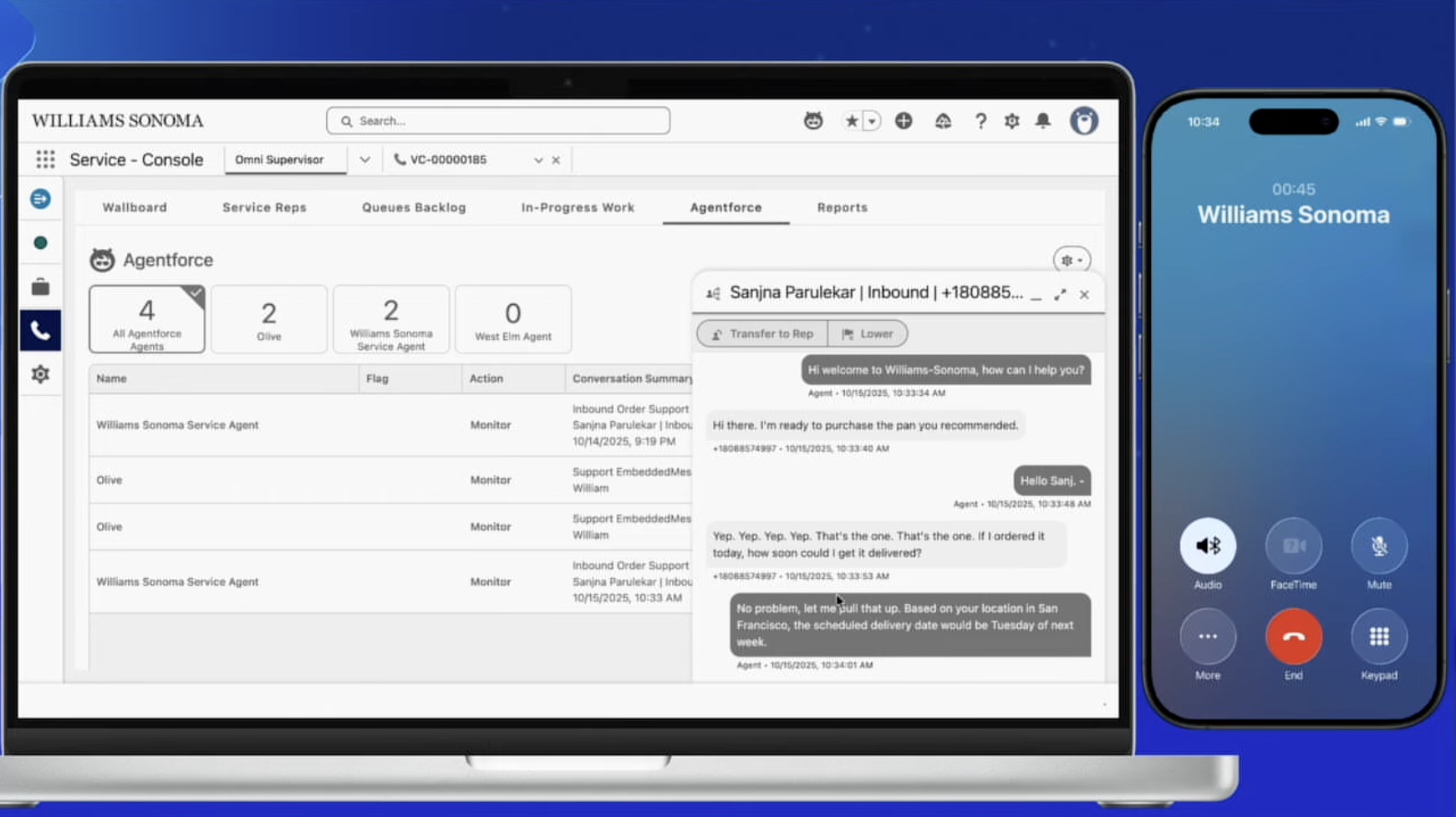
Salesforce also previewed multi-channel continuity, where agents retain context as users move between web, Slack, and Voice. Agents can now return rich UI elements such as tables, images, and carousels within chat interactions.
Observability and analytics
New Agent Insights and Analytics tools (Beta November 2025) give teams visibility into performance metrics such as resolution rate, escalation trends, and session-level behavior. Tableau-powered dashboards and transcript drilldowns make it easier to identify issues and improve reliability over time.
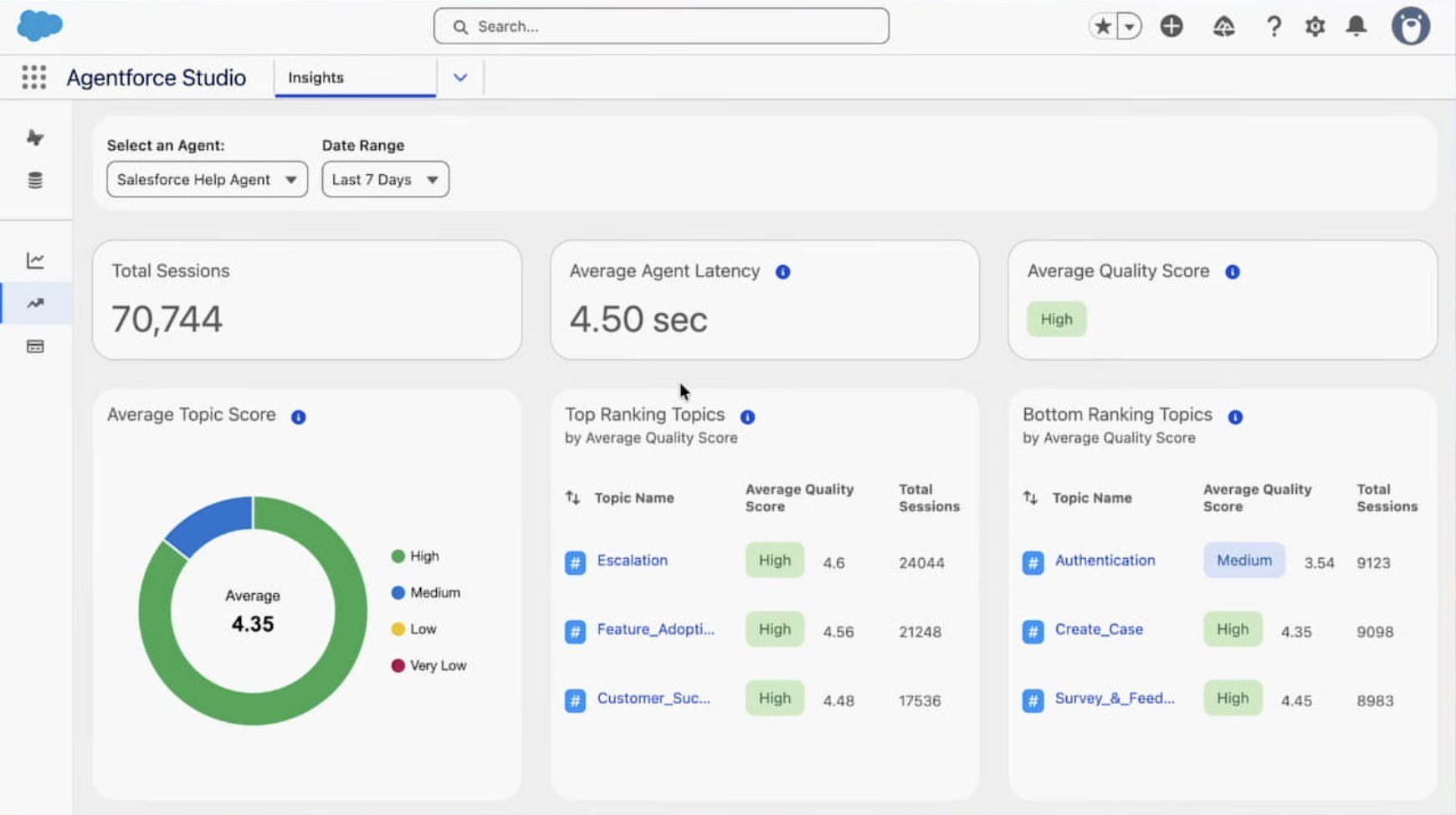
Agentforce Grid: orchestration at scale
The newly introduced Agentforce Grid (Beta November 2025) allows teams to run agents, prompts, and actions in parallel across a spreadsheet-style interface. It’s designed for use cases like classifying support issues, running batch analyses, and automating operational outreach — with context dynamically pulled into each task.
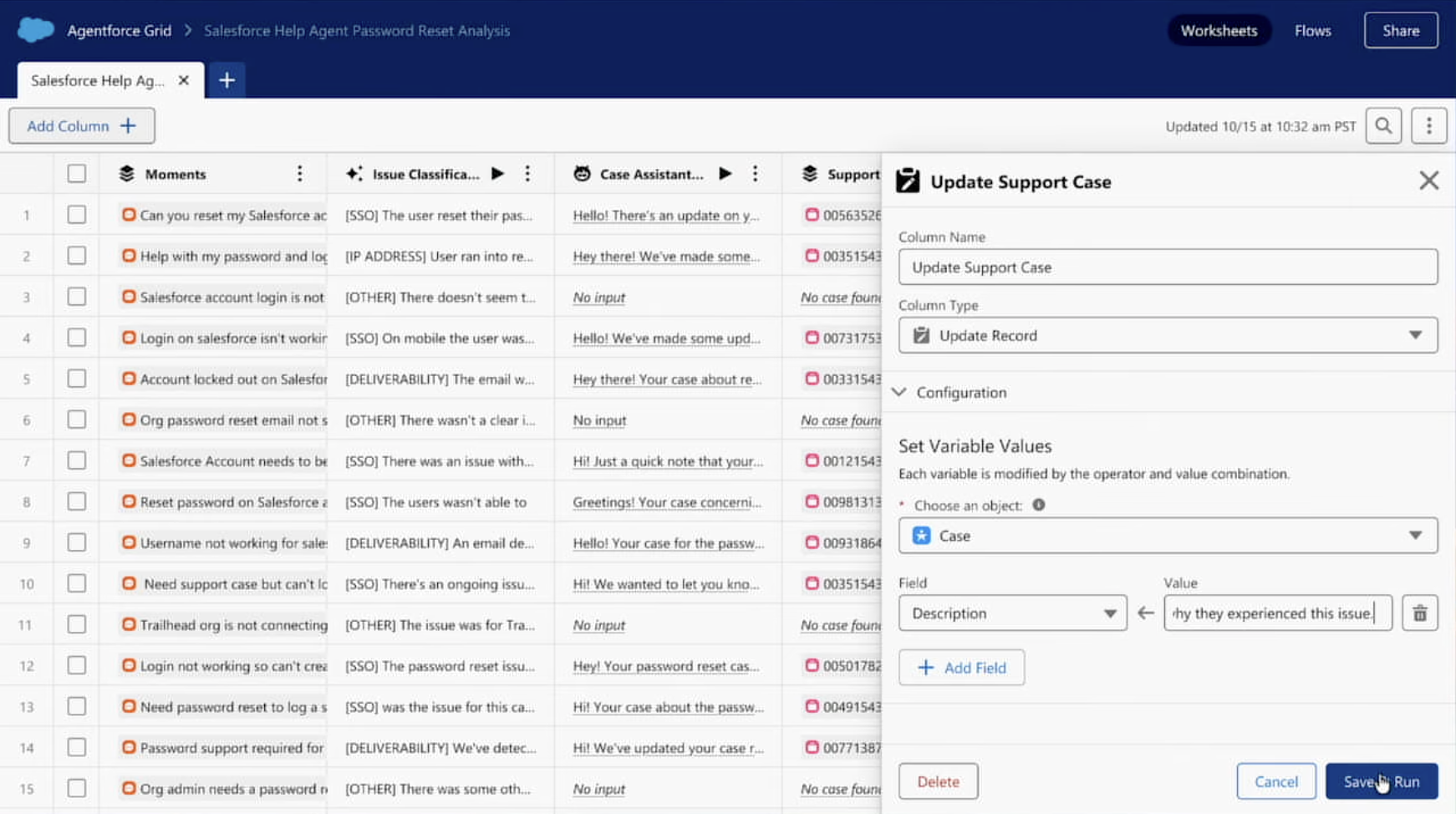
Real-world use cases
The keynote included real customer stories to illustrate how these capabilities work in production.
- Equinox demonstrated a live website agent that helps members discover classes and services while reflecting the company’s tone and branding.
- Williams-Sonoma showcased “Olive,” an AI shopping assistant that launched in under a month and now operates across both web and voice experiences.
Why this matters for DevOps
For DevOps teams, Agentforce 360 represents a shift toward agent lifecycle management. Agents can now be versioned, tested, and monitored like any other part of the software stack.
Observability dashboards, reasoning traces, and rollback features bring agentic workflows into CI/CD pipelines, while the new metrics framework gives teams a way to measure performance and reliability in production.
As agents become central to how Salesforce environments operate, DevOps teams will play a key role in maintaining trust, traceability, and control — ensuring that automation remains accountable at scale.
Summary
Day Two moved Salesforce’s agentic story from concept to craft. The sessions for admins and developers revealed a practical roadmap for building, testing, and governing agents safely — while the Agentforce updates showed how these systems can operate at scale.
For DevOps teams, the message was clear: as agents become part of production environments, deployment pipelines must evolve to include testing, observability, and governance for AI-driven components.
Check back in tomorrow for Dreamforce Day Three roundup, highlights, and key takeaways.
Learn more with DevOps Launchpad
Explore free, expert-led courses and certifications on DevOps Launchpad — including courses for admins, developers, and those looking to get started with Agentforce.